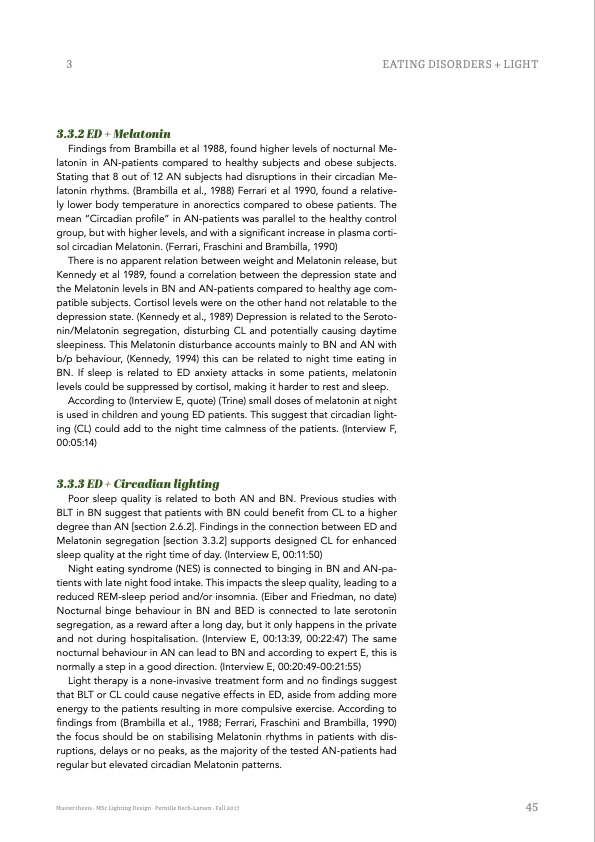
PDF Publication Title:
Text from PDF Page: 045
3 EATING DISORDERS + LIGHT 3.3.2 ED + Melatonin Findings from Brambilla et al 1988, found higher levels of nocturnal Me- latonin in AN-patients compared to healthy subjects and obese subjects. Stating that 8 out of 12 AN subjects had disruptions in their circadian Me- latonin rhythms. (Brambilla et al., 1988) Ferrari et al 1990, found a relative- ly lower body temperature in anorectics compared to obese patients. The mean “Circadian profile” in AN-patients was parallel to the healthy control group, but with higher levels, and with a significant increase in plasma corti- sol circadian Melatonin. (Ferrari, Fraschini and Brambilla, 1990) There is no apparent relation between weight and Melatonin release, but Kennedy et al 1989, found a correlation between the depression state and the Melatonin levels in BN and AN-patients compared to healthy age com- patible subjects. Cortisol levels were on the other hand not relatable to the depression state. (Kennedy et al., 1989) Depression is related to the Seroto- nin/Melatonin segregation, disturbing CL and potentially causing daytime sleepiness. This Melatonin disturbance accounts mainly to BN and AN with b/p behaviour, (Kennedy, 1994) this can be related to night time eating in BN. If sleep is related to ED anxiety attacks in some patients, melatonin levels could be suppressed by cortisol, making it harder to rest and sleep. According to (Interview E, quote) (Trine) small doses of melatonin at night is used in children and young ED patients. This suggest that circadian light- ing (CL) could add to the night time calmness of the patients. (Interview F, 00:05:14) 3.3.3 ED + Circadian lighting Poor sleep quality is related to both AN and BN. Previous studies with BLT in BN suggest that patients with BN could benefit from CL to a higher degree than AN [section 2.6.2]. Findings in the connection between ED and Melatonin segregation [section 3.3.2] supports designed CL for enhanced sleep quality at the right time of day. (Interview E, 00:11:50) Night eating syndrome (NES) is connected to binging in BN and AN-pa- tients with late night food intake. This impacts the sleep quality, leading to a reduced REM-sleep period and/or insomnia. (Eiber and Friedman, no date) Nocturnal binge behaviour in BN and BED is connected to late serotonin segregation, as a reward after a long day, but it only happens in the private and not during hospitalisation. (Interview E, 00:13:39, 00:22:47) The same nocturnal behaviour in AN can lead to BN and according to expert E, this is normally a step in a good direction. (Interview E, 00:20:49-00:21:55) Light therapy is a none-invasive treatment form and no findings suggest that BLT or CL could cause negative effects in ED, aside from adding more energy to the patients resulting in more compulsive exercise. According to findings from (Brambilla et al., 1988; Ferrari, Fraschini and Brambilla, 1990) the focus should be on stabilising Melatonin rhythms in patients with dis- ruptions, delays or no peaks, as the majority of the tested AN-patients had regular but elevated circadian Melatonin patterns. Master thesis · MSc Lighting Design · Pernille Bech-Larsen · Fall 2017 45PDF Image | Healing with light

PDF Search Title:
Healing with lightOriginal File Name Searched:
THESIS_200118_PBL_FINAL.pdfDIY PDF Search: Google It | Yahoo | Bing
Cruise Ship Reviews | Luxury Resort | Jet | Yacht | and Travel Tech More Info
Cruising Review Topics and Articles More Info
Software based on Filemaker for the travel industry More Info
The Burgenstock Resort: Reviews on CruisingReview website... More Info
Resort Reviews: World Class resorts... More Info
The Riffelalp Resort: Reviews on CruisingReview website... More Info
| CONTACT TEL: 608-238-6001 Email: greg@cruisingreview.com | RSS | AMP |